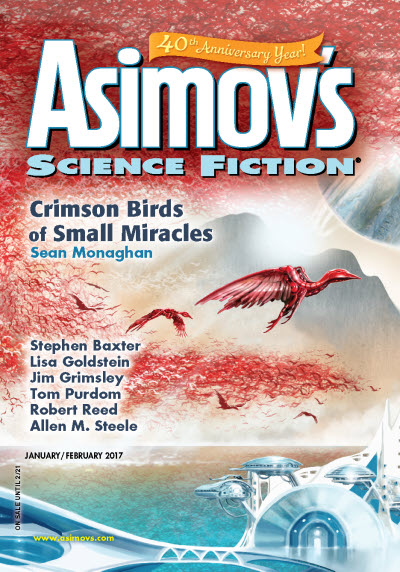Asimov’s Science Fiction, Vol. 41, Nos. 1 & 2 (January/February 2017)
 This year marks the 40-year anniversary of Asimov’s and this issue not only includes a brief recap of the magazine’s history in an editorial, but also comments from each of the contributing authors about when they first read the magazine and what it means to them.
This year marks the 40-year anniversary of Asimov’s and this issue not only includes a brief recap of the magazine’s history in an editorial, but also comments from each of the contributing authors about when they first read the magazine and what it means to them.
Check out the cover art by Maurizio Manzieri. That’s a scene from the first story in the magazine, “Crimson Birds of Small Miracles” by Sean Monaghan. On the surface, the story is about a father taking his two daughters to see the beautiful mechanical birds of the title, but there is also a much deeper and more touching story at work here, illustrating the truth that some tragedies will continue to follow us into the future, no matter how many advances we make with technology.
Next is “Tagging Bruno” by Allen M. Steele, a tale set in the future and on another world, yet concerned with current debates on wildlife preservation. Sure, it gets a little preachy, but the characters are all well-defined and the ending has just a tinge of fun irony to it.
“Still Life with Abyss” by Jim Grimsley starts with that old science fiction trope of the parallel universe and reverses the standard story. It’s set in a research station that monitors activities in all of the parallel universes. Of course, there are the usual “What if?” universes (America lost the Revolution, the South won the Civil War, the Nazis won World War II), but also all of the small changes in individual people’s lives. The idea is that we all have alternate paths that our lives might have taken and on some parallel world, we did. But the research team has discovered one man, one solitary man in all the recorded multiverse, whose life NEVER deviates from a single course, no matter what happens around him.
“Fatherbond” by Tim Purdom follows a group of human colonists who arrive on a new world, only to discover that another race of aliens has already arrived and is forbidding anyone to colonize it. The argument against colonizing is an interesting one. While there is no intelligent life native to the planet, intelligent life might naturally evolve there over hundreds of millions of years. So colonization is wrong not because it would displace current inhabitants, but rather because it would interfere with the natural evolution of future inhabitants. Obviously, some of the humans feel differently and the aliens’ motives aren’t as pure as initially stated.











